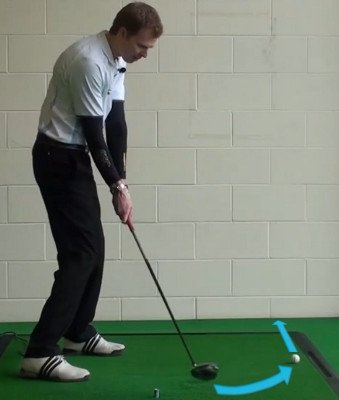If you want to gain more distance off the tee, learning to draw the ball can be an effective technique. A draw is a shot that starts to the right of the target (for a right-handed golfer) and then gently curves back towards the target. Here are some tips to help you learn to draw the ball: 
- Grip adjustment: One of the key elements in creating a draw is adjusting your grip. For a right-handed golfer, rotate your hands slightly to the right on the grip. This promotes a more closed clubface at impact, which helps generate the desired draw spin.
- Align your body to the right: To encourage an in-to-out swing path, align your body slightly to the right of the target (for a right-handed golfer). This alignment helps you swing from the inside, promoting the desired draw.
- Swing path: To hit a draw, focus on swinging from inside the target line to outside. This means your clubhead should approach the ball from slightly inside the target line and then move towards the right after impact. This swing path helps promote the right-to-left spin necessary for a draw.
- Clubface position: At impact, the clubface should be slightly closed relative to the swing path. This closed face position helps create the initial right-to-left spin. Experiment with the position of your hands at impact to achieve the desired clubface position.
- Weight transfer: Proper weight transfer is crucial for generating power and a proper swing path. As you swing, transfer your weight onto your front foot during the downswing, promoting an in-to-out swing path and a draw.
- Practice with drills: There are various drills you can use to practice hitting draws. One popular drill is the “gate drill.” Set up two alignment sticks or clubs on the ground, forming a gate slightly wider than the width of your clubhead. Practice hitting shots through the gate, focusing on the correct swing path and clubface position to produce a draw.
- Gradual adjustments: When learning to hit a draw, it's important to make gradual adjustments. Start by making small changes to your grip, alignment, and swing path. As you become more comfortable, you can make further adjustments to produce a more pronounced draw.
- Seek professional guidance: If you're struggling to hit a draw consistently, consider seeking guidance from a golf professional. They can provide personalized instruction and help you make the necessary adjustments to your swing.
Remember, learning to hit a draw takes time and practice. Be patient with yourself and focus on making incremental improvements. Experiment with different grip and swing adjustments, and dedicate practice time to mastering this shot. With practice, you'll gain more distance off the tee and add another valuable shot to your golf repertoire.





